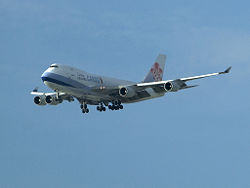Fixed-wing aircraft: Difference between revisions
imported>Subpagination Bot m (Add {{subpages}} and remove any categories (details)) |
mNo edit summary |
||
| (2 intermediate revisions by 2 users not shown) | |||
| Line 3: | Line 3: | ||
[[Image:Boeing 747 cargo jet.jpg|right|thumb|250px|{{#ifexist:Template:Boeing 747 cargo jet.jpg/credit|{{Boeing 747 cargo jet.jpg/credit}}<br/>|}}The [[Boeing 747]] is one of the largest fixed-wing aircraft ever built.]] | [[Image:Boeing 747 cargo jet.jpg|right|thumb|250px|{{#ifexist:Template:Boeing 747 cargo jet.jpg/credit|{{Boeing 747 cargo jet.jpg/credit}}<br/>|}}The [[Boeing 747]] is one of the largest fixed-wing aircraft ever built.]] | ||
'''Fixed-wing aircraft''' are vehicles that remain aloft | '''Fixed-wing aircraft''' are vehicles that remain aloft using the [[lift (force)|aerodynamic lift]] from the flow of air over [[wing]]s which are fixed in position, in relation to the rest of their structure. Some or all of the vehicle is shaped as an [[airfoil]]. | ||
When powered they are called airplanes (American) or aeroplanes (British). | |||
When powered they are called airplanes (American) or aeroplanes (British). Powered aircraft may use rotating airfoils perpendicular to the direction of flight (i.e., [[propellers]]), or can use hot gases that go out a nozzle 180 degrees from the direction of flight, causing the aircaft to move forward in reaction to the action of the gases. Reaction propulsion is always generated by a [[jet engine]] or [[rocket engine]], while propellers may be spun by a specialized jet engine called a [[turboprop]], or by a [[reciprocating engine]]. | |||
When unpowered, they are called [[glider]]s. | When unpowered, they are called [[glider]]s. | ||
Fixed-wing aircraft are distinct from [[rotary-wing aircraft]] such as [[helicopter]]s and [[gyroplane]]s which have an airfoil that moves with respect to the rest of the aircraft's structure. [[Tilt-rotor aircraft]] are a hybrid between fixed and rotary wing; the rotating airfoils are mounted on a pivoting support; when it pivots so that the rotating airfoils point up, it operates as a helicopter, but when it pivots the rotating airfoils 90 degrees toward the noise, the support becomes a fixed wing and the rotary airfoils act as propellers.[[Category:Suggestion Bot Tag]] | |||
Fixed-wing aircraft are distinct from [[rotary-wing aircraft]] such as | |||
[[helicopter]]s and [[gyroplane]]s which have an airfoil that moves | |||
with respect to the aircraft | |||
Latest revision as of 06:00, 17 August 2024

Fixed-wing aircraft are vehicles that remain aloft using the aerodynamic lift from the flow of air over wings which are fixed in position, in relation to the rest of their structure. Some or all of the vehicle is shaped as an airfoil.
When powered they are called airplanes (American) or aeroplanes (British). Powered aircraft may use rotating airfoils perpendicular to the direction of flight (i.e., propellers), or can use hot gases that go out a nozzle 180 degrees from the direction of flight, causing the aircaft to move forward in reaction to the action of the gases. Reaction propulsion is always generated by a jet engine or rocket engine, while propellers may be spun by a specialized jet engine called a turboprop, or by a reciprocating engine.
When unpowered, they are called gliders.
Fixed-wing aircraft are distinct from rotary-wing aircraft such as helicopters and gyroplanes which have an airfoil that moves with respect to the rest of the aircraft's structure. Tilt-rotor aircraft are a hybrid between fixed and rotary wing; the rotating airfoils are mounted on a pivoting support; when it pivots so that the rotating airfoils point up, it operates as a helicopter, but when it pivots the rotating airfoils 90 degrees toward the noise, the support becomes a fixed wing and the rotary airfoils act as propellers.